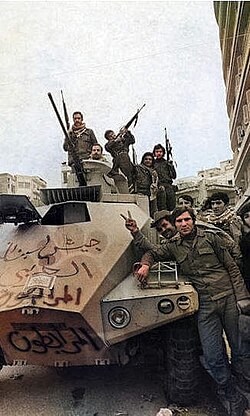
The Lebanese Civil War was a conflict which raged in Lebanon between 1975 and 1990. The primary cause of the conflict was longstanding political, religious and social divisions in a country which, somewhat unusually for the Middle East, has a large Christian community and a number of significant ethno-religious minorities such as the Druze people. The conflict also took on a regional aspect to it as countries like Syria, Israel, Iran, the United States, France and the United Kingdom all intervened in it for various reasons and to differing degrees. There were many competing entities at work in Lebanon as a result and the conflict was much more than simply two opposing sides engaged in a power struggle. It only gradually came to an end following the Taif Agreement of 1989, but Lebanon continues to struggle under the legacy of the civil war three and half decades later. 150,000 people were killed in the fighting and a million more people were displaced. Between 600,000 and 900,000 left the country between 1975 and 1990.[1]
Lebanese Civil War chronology of eventsLebanese Civil War chronology of events

Lebanon is the most religiously and culturally diverse country in the Middle East. This is owing to a wide range of factors, including the country’s long coastal and maritime tradition, which has ensured that Christianity has continued to thrive here through connections to the Greek Orthodox world and the world of Roman Catholicism in Western and Southern Europe, along with the development of several religious sects here such as that of the Druze, an ethno-religious group. Indeed Lebanon owes its distinct political identity today to the fact that the French, who acquired the region as part of their Syrian Mandate after the First World War, hived Lebanon off from Syria and managed it separately, such was its peculiar religious and ethnic environment.[2]
This diversity made Lebanon a culturally vibrant place in the middle of the twentieth century and the city of Beirut became known as the Paris of the Middle East.[3] But it was also Lebanon’s undoing. In the 1960s and early 1970s political, religious and ethnic tensions grew, fuelled by wider geopolitical issues in the Levant, notably the arrival of hundreds of thousands of Palestinian refugees from the mid-1940s onwards.[4]

It is not possible to categorize the conflict which now developed as being between two different sides in a straight-forward civil war. Instead the established government faced competition from numerous competing entities with different agendas. For instance, the Lebanese Front was a coalition of largely Christian groups that had the backing of neighboring Israel and was pressing the agenda of the Christian population of Lebanon. The Lebanese National Movement was a left-wing, pan-Arab movement that was fighting for the cause of Muslims in Lebanon. It would eventually acquire support from Iran and several other Islamic countries. Hezbollah, the paramilitary Islamic group which still plays a major role in Lebanese and the regional politics of the Levant today, emerged in the mid-1980s. Syria also intervened in a substantial and direct way in the conflict. Finally, countries like the United States, France and the United Kingdom played a role too in the civil war, mostly in the shape of trying to prop up the established government of Lebanon against the many challengers it faced.[5]
After years of conflict, foreign interventions and the arrival of peacekeeping forces, a peace agreement was finally patched together in 1989. Under the Taif Agreement, signed in Saudi Arabia, it was concluded that the Christian South Lebanon Army would relinquish control of southern Lebanon, which it largely controlled, back to the government and that Israel would remove its troops from the region too. The Syrians were also to evacuate their forces, though in the end this would not be fully undertaken until 2005. A major political concession was that Christians, who under the independence agreement when France left Lebanon had been guaranteed a slight majority of representatives in the Lebanese parliament over Muslims would henceforth have a 50-50 share of delegates with Muslims.[6]
At least 150,000 people died during the fighting in the Lebanese Civil War and some studies place the figure closer to 180,000. It is difficult to tell, as owing to confessional divisions in the country a full census has not been carried out there since 1932. While peace was established in 1990 following the Taif Agreement, Lebanon has never fully recovered. Parts of the country are dominated by Hezbollah and other groups that first emerged during the civil war, while there are also long-lasting economic and political problems, most notably unresolved tensions between Shia and Sunni Muslims. These issues have been further exacerbated since 2011 by the spill-over of refugees into Lebanon as a result of the Syrian Civil War.[7]
Extent of migration associated with the Lebanese Civil WarExtent of migration associated with the Lebanese Civil War
The Lebanese Civil War led to somewhere between 600,000 and 900,000 people leaving Lebanon altogether, a huge figure in a country with a relatively small population. It is difficult to put an exact figure on this as the level of turbulence that the region had experienced over the decades prior to the civil war meant some people were undocumented in Lebanon before they left again, making precise migration and refugee figures impossible to establish. When this is combined with continued migration in the 1990s and 2000s, notably during the 2006 Lebanon War, well over a million Lebanese people have left the country since 1975. They have migrated far afield, with the Lebanese diaspora being particularly large in the United States, France, Australia, Canada and Germany. There was also a very large Lebanese diaspora community in countries like Brazil, Argentina, Columbia and Venezuela from migratory patterns in the century prior to the civil war. These have been augmented owing to the civil war migration.[8]
Demographic impact of the Lebanese Civil WarDemographic impact of the Lebanese Civil War
The demographic impact of the Lebanese Civil War has been very considerable. One of the most notable elements of it is that the percentage of the population that are Christian has fallen from around 50% to somewhere between 35% and 40% today, while the number of Muslims has proportionately increased. Abroad large Lebanese communities have emerged in numerous countries as a result of the migration associated with the civil war. Some countries like Brazil and Argentina already had large Lebanese communities prior to 1975, but those in the United States, Canada and Australia owe much of their existence to the civil war era. Accordingly, many of the one million people of Lebanese ancestry who live in these three countries today will be able to trace their family history back to Lebanon in the tumultuous period between 1975 and 1990 when their parents or grandparents decided to leave their homeland.[9]
See alsoSee also
Explore more about the Lebanese Civil WarExplore more about the Lebanese Civil War
- The Historiography and the Memory of the Lebanese Civil War at Sciences Po
- The Lebanese Civil War at The Collector
- What is Hezbollah? at Council on Foreign Relations
References
- ↑ https://www.sciencespo.fr/mass-violence-war-massacre-resistance/fr/document/historiography-and-memory-lebanese-civil-war.html
- ↑ https://www.worldatlas.com/articles/the-culture-of-lebanon.html
- ↑ https://edition.cnn.com/travel/article/beirut-five-star-hotels-faded-glamor-cnngo/index.html
- ↑ https://discovery.ucl.ac.uk/id/eprint/10170515/3/Irfan_Palestinian%20Refugees%20JPRS%20article_July%202017.pdf
- ↑ https://www.thecollector.com/lebanese-civil-war-conflict/
- ↑ https://www.middleeastmonitor.com/20201022-remembering-the-taif-accord/
- ↑ https://gjia.georgetown.edu/2024/04/16/an-identity-quandary-in-lebanon/
- ↑ https://www.migrationpolicy.org/article/lebanese-crisis-and-its-impact-immigrants-and-refugees
- ↑ https://www.migrationpolicy.org/article/lebanese-crisis-and-its-impact-immigrants-and-refugees


